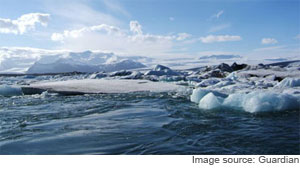 If a glacier falls into the ocean, and no one is there to record it, did it really happen? Perhaps anticipating the question, artist Katie Paterson has created an art installation in which the sounds of Iceland glaciers are recorded through a real-time feed from her cell phone. Audiences that see her cell number displayed at an art gallery in London can call the number and listen, live, to the sounds of large pieces of ice groaning, cracking, and breathing their last.
If a glacier falls into the ocean, and no one is there to record it, did it really happen? Perhaps anticipating the question, artist Katie Paterson has created an art installation in which the sounds of Iceland glaciers are recorded through a real-time feed from her cell phone. Audiences that see her cell number displayed at an art gallery in London can call the number and listen, live, to the sounds of large pieces of ice groaning, cracking, and breathing their last.
As global warming changes the landscape and seascape of our planet in a way that feels as permanent as it does ominous, people are already finding ways to remember the natural world as it once existed, or at least bear witness as it changes. In Greenland, glaciers are melting fast, too, reports The Washington Post. One woman marvels at the fact that global warming seems to have left a permanent mark on the island. “Already we are starting our sentences by saying, ‘In the days when it was cold … We’re starting to talk about it like it was history, and it’s only been about five years.”
Human civilization has always found ways to remember what is important to its essence. The Inuits of Greenland use good old-fashioned oral history, and a British art student uses a cell phone. But are these acts of remembrance thinly veiled resignations—signs that we’re giving up hope for the planet? Or, on the other hand, can they help to inspire us? In the Hebrew scriptures, the God of ancient Israel repeatedly called the nation to remember their roots, often as a way of waking them up. Maybe the fact that our ice caps are becoming history should serve as a wake-up call for us.
Jesse Holcomb, a former Sojourners intern, performs content analysis at the Project for Excellence in Journalism and is a graduate student at George Washington University’s School of Media and Public Affairs.

